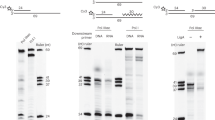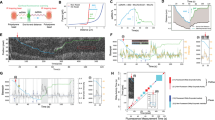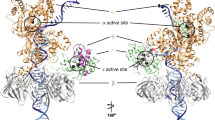Abstract
A hallmark feature of DNA replication is the coordination between the continuous polymerization of nucleotides on the leading strand and the discontinuous synthesis of DNA on the lagging strand1. This synchronization requires a precisely timed series of enzymatic steps that control the synthesis of an RNA primer, the recycling of the lagging-strand DNA polymerase, and the production of an Okazaki fragment. Primases synthesize RNA primers at a rate that is orders of magnitude lower2,3,4 than the rate of DNA synthesis by the DNA polymerases at the fork. Furthermore, the recycling of the lagging-strand DNA polymerase from a finished Okazaki fragment to a new primer is inherently slower than the rate of nucleotide polymerization5. Different models have been put forward to explain how these slow enzymatic steps can take place at the lagging strand without losing coordination with the continuous and fast leading-strand synthesis6,7,8. Nonetheless, a clear picture remains elusive. Here we use single-molecule techniques to study the kinetics of a multiprotein replication complex from bacteriophage T7 and to characterize the effect of primase activity on fork progression. We observe the synthesis of primers on the lagging strand to cause transient pausing of the highly processive leading-strand synthesis. In the presence of both leading- and lagging-strand synthesis, we observe the formation and release of a replication loop on the lagging strand. Before loop formation, the primase acts as a molecular brake and transiently halts progression of the replication fork. This observation suggests a mechanism that prevents leading-strand synthesis from outpacing lagging-strand synthesis during the slow enzymatic steps on the lagging strand.
This is a preview of subscription content, access via your institution
Access options
Subscribe to this journal
Receive 51 print issues and online access
$199.00 per year
only $3.90 per issue
Buy this article
- Purchase on SpringerLink
- Instant access to full article PDF
Prices may be subject to local taxes which are calculated during checkout




Similar content being viewed by others
References
Alberts, B. DNA replication and recombination. Nature 421, 431–435 (2003)
Sheaff, R. J. & Kuchta, R. D. Mechanism of calf thymus DNA primase: slow initiation, rapid polymerization, and intelligent termination. Biochemistry 32, 3027–3037 (1993)
Swart, J. R. & Griep, M. A. Primer synthesis kinetics by Escherichia coli primase on single-stranded DNA templates. Biochemistry 34, 16097–16106 (1995)
Frick, D. N., Kumar, S. & Richardson, C. C. Interaction of ribonucleoside triphosphates with the gene 4 primase of bacteriophage T7. J. Biol. Chem. 274, 35899–35907 (1999)
Stukenberg, P. T., Turner, J. & O'Donnell, M. An explanation for lagging strand replication: polymerase hopping among DNA sliding clamps. Cell 78, 877–887 (1994)
Salinas, F. & Benkovic, S. J. Characterization of bacteriophage T4-coordinated leading- and lagging-strand synthesis on a minicircle substrate. Proc. Natl Acad. Sci. USA 97, 7196–7201 (2000)
Tougu, K. & Marians, K. J. The interaction between helicase and primase sets the replication fork clock. J. Biol. Chem. 271, 21398–21405 (1996)
Lee, J., Chastain, P. D. II, Griffith, J. D. & Richardson, C. C. Lagging strand synthesis in coordinated DNA synthesis by bacteriophage T7 replication proteins. J. Mol. Biol. 316, 19–34 (2002)
Benkovic, S. J., Valentine, A. M. & Salinas, F. Replisome-mediated DNA replication. Annu. Rev. Biochem. 70, 181–208 (2001)
Tabor, S., Huber, H. E. & Richardson, C. C. Escherichia coli thioredoxin confers processivity on the DNA polymerase activity of the gene 5 protein of bacteriophage T7. J. Biol. Chem. 262, 16212–16223 (1987)
Guo, S., Tabor, S. & Richardson, C. C. The linker region between the helicase and primase domains of the bacteriophage T7 gene 4 protein is critical for hexamer formation. J. Biol. Chem. 274, 30303–30309 (1999)
Frick, D. N., Baradaran, K. & Richardson, C. C. An N-terminal fragment of the gene 4 helicase/primase of bacteriophage T7 retains primase activity in the absence of helicase activity. Proc. Natl Acad. Sci. USA 95, 7957–7962 (1998)
Kusakabe, T., Baradaran, K., Lee, J. & Richardson, C. C. R. Roles of the helicase and primase domain of the gene 4 protein of bacteriophage T7 in accessing the primase recognition site. EMBO J. 17, 1542–1552 (1998)
van Oijen, A. M. et al. Single-molecule kinetics of lambda exonuclease reveal base dependence and dynamic disorder. Science 301, 1235–1238 (2003)
Bustamante, C., Smith, S. B., Liphardt, J. & Smith, D. Single-molecule studies of DNA mechanics. Curr. Opin. Struct. Biol. 10, 279–285 (2000)
Wuite, G. J., Smith, S. B., Young, M., Keller, D. & Bustamante, C. Single-molecule studies of the effect of template tension on T7 DNA polymerase activity. Nature 404, 103–106 (2000)
Maier, B., Bensimon, D. & Croquette, V. Replication by a single DNA polymerase of a stretched single-stranded DNA. Proc. Natl Acad. Sci. USA 97, 12002–12007 (2000)
Ahnert, P., Picha, K. M. & Patel, S. S. A ring-opening mechanism for DNA binding in the central channel of the T7 helicase-primase protein. EMBO J. 19, 3418–3427 (2000)
Hamdan, S. M. et al. A unique loop in T7 DNA polymerase mediates the binding of helicase-primase, DNA binding protein, and processivity factor. Proc. Natl Acad. Sci. USA 102, 5096–5101 (2005)
Kolodner, R. & Richardson, C. C. Gene 4 protein of bacteriophage T7. Characterization of the product synthesized by the T7 DNA polymerase and gene 4 protein in the absence of ribonucleoside 5′-triphosphates. J. Biol. Chem. 253, 574–584 (1978)
Jeong, Y. J., Levin, M. K. & Patel, S. S. The DNA-unwinding mechanism of the ring helicase of bacteriophage T7. Proc. Natl Acad. Sci. USA 101, 7264–7269 (2004)
Stano, N. M. et al. DNA synthesis provides the driving force to accelerate DNA unwinding by a helicase. Nature 435, 370–373 (2005)
Frick, D. N. & Richardson, C. C. Interaction of bacteriophage T7 gene 4 primase with its template recognition site. J. Biol. Chem. 274, 35889–35898 (1999)
Bernstein, J. A. & Richardson, C. C. A 7-kDa region of the bacteriophage T7 gene 4 protein is required for primase but not for helicase activity. Proc. Natl Acad. Sci. USA 85, 396–400 (1988)
Bernstein, J. A. & Richardson, C. C. Purification of the 56-kDa component of the bacteriophage T7 primase/helicase and characterization of its nucleoside 5′-triphosphatase activity. J. Biol. Chem. 263, 14891–14899 (1988)
He, Z.-G. & Richardson, C. C. Effect of single-stranded DNA-binding proteins on the helicase and primase activities of the bacteriophage T7 gene 4 protein. J. Biol. Chem. 279, 22190–22197 (2004)
Yang, J., Xi, J., Zhuang, Z. & Benkovic, S. J. The oligomeric T4 primase is the functional form during replication. J. Biol. Chem. 280, 25416–25423 (2005)
Mitkova, A. V., Khopde, S. M. & Biswas, S. B. Mechanism and stoichiometry of interaction of DnaG primase with DnaB helicase of Escherichia coli in RNA primer synthesis. J. Biol. Chem. 278, 52253–52261 (2005)
Thompson, R. E., Larson, D. R. & Webb, W. W. Precise nanometer localization analysis for individual fluorescent probes. Biophys. J. 82, 2775–2783 (2002)
Notarnicola, S. M., Mulcahy, H. L., Lee, J. & Richardson, C. C. The acidic carboxyl terminus of the bacteriophage T7 gene 4 helicase/primase interacts with T7 DNA polymerase. J. Biol. Chem. 272, 18425–18433 (1997)
Acknowledgements
We wish to thank T. Ellenberger, D. Crampton and P. Blainey for discussions and comments, and S. Buratowski for critically reading the manuscript. We are grateful to S.-J. Lee for providing the purified ZBD-less gp4 variant. We thank S. Moskowitz for preparation of the figures. This work was supported by grants from the NIH to C.C.R. and X.S.X.
Author information
Authors and Affiliations
Corresponding author
Ethics declarations
Competing interests
Reprints and permissions information is available at npg.nature.com/reprintsandpermissions. The authors declare no competing financial interests.
Supplementary information
Supplementary Notes
This file contains Supplementary Methods, Supplementary Figures S1−S9, and additional references. (PDF 487 kb)
Rights and permissions
About this article
Cite this article
Lee, JB., Hite, R., Hamdan, S. et al. DNA primase acts as a molecular brake in DNA replication. Nature 439, 621–624 (2006). https://doi.org/10.1038/nature04317
Received:
Accepted:
Issue Date:
DOI: https://doi.org/10.1038/nature04317



